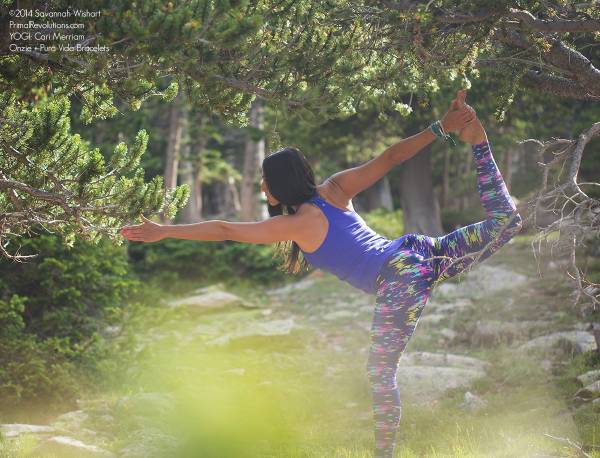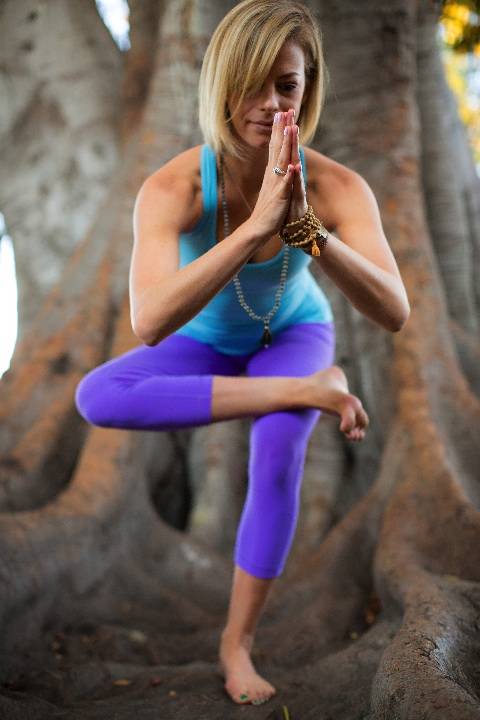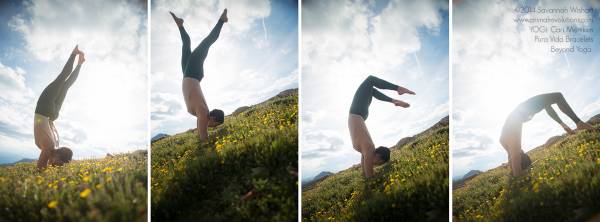One of my favorite places to practice yoga is on the warm sand of a California beach. I always feel primal practicing yoga outside the studio, with the dirt sticking to my sweat and the noises of every day life swirling around me.
But whether you are practicing on the beach, in your yard, or in a park, if you are outside on an unpredictable soft service, then you put your joints under more stress than when you practice on hard floors. Follow these simple tips to keep your outdoor yoga practice safe while you connect with nature and fresh air.
Skip the Vinyasa Flow
The wrists are most vulnerable to pain and injury when practicing on a soft service. The heels of the hands have a tendency to dig into the ground, collapsing the wrist and putting pressure on the ulna bone where it connects on the outer hand.
To relieve the wrists, stay away from too many down dog holds or vinyasa flows. Opt for salutations to warm the body if desired, but after your initial warm up, simply choose to step back into postures from tadasana (mountain pose).
Lose the Yoga Mat
Yoga mats, particularly thick mats, are designed to provide some cushion and anti-slip when placed on solid services. Put your yoga mat down on the sand or grass, though, and you will find it bunches, folds, and makes a softer service even harder to navigate.
Mexican yoga blankets or simple beach towels are better options for practicing outdoors. These services will cling to the Earth, forming to the natural surface without making it any softer. As an additional benefit, if you put your towel or blanket down in the mud, you can simply toss it in the washing machine after practice.

Forego the Music
I am a big fan of practicing to music. Artists of all type inspire me to connect deeper with my inner creativity, and I love how the rhythm of my breath naturally follows the rhythm of a beautiful song while I move into my practice. But, studies show human happiness is increased immediately when we connect with nature. In the absence of music, we can appreciate more fully the sounds around us when we’re outside.
Listen for the waves on the beach, the sound of animals, the breeze in the trees and even the sounds of “disturbances” like people talking or planes flying overhead. When you turn your senses outward during practice and tune into nature, you exhaust the senses and are prepared to turn them inward come time for savasana (final relaxation).
Practice Balancing Poses
The instability caused by an uneven surface may be tough on the wrists, but it is great to work the fast-twitch muscles of the ankles and feet in balancing poses. If you’re unsure where to start, tree pose is an excellent balancing option for all levels of yogis. Other balancing options great for outdoors include eagle pose, standing hand-to-big-toe pose, dancer pose (pictured above), and temple dancer (pictured below).

Go Upside Down
The one exception I make to standing on the wrists too much while on soft surfaces is the handstand. There are two main benefits to hand-standing outside:
- If you fall on sand or grass, it is more forgiving than hardwoods. This fact alone makes many people who normally rely on the wall when hand-standing much bolder outside.
- The soft surface will force you to activate your fingers and grip into the Earth. This is great practice for when you return to the studio, as active fingers enhance your ability to balance.

If hand-standing is not for you, go upside down any way you like. You can choose headstand, shoulder stand, or simply lying on your back with your legs up in the air. Keep your eyes open and appreciate what the world looks like upside down. I particularly like to look out at the ocean horizon when in a headstand as this steady view brings so much calm to my mind and body.
As the summer days stretch out a little shorter, take advantage of these nice temperatures while they last. Get outside and practice, even in the full sun of the afternoon (with sunscreen on of course) and feel how being with nature helps you connect even deeper to the sense of being with yourself.
Photo 3 courtesy of Tai Kerbs.
All other photos courtesy of Savannah Wishart.






